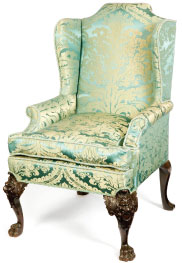The Georgian Period (1714-1830) combined the art of furniture craftsmanship with the art of marble work. Marble is a stone to which we generally ascribe a connotation of richness, luxury and eternity. A favourite medium for the Greek and Roman Sculptors and Architects, marble has become a cultural symbol of tradition and refined taste. The Georgian Period promulgated a shift towards proportion and balance, architecture and design were imbued with symmetry and adherence to classical rules. The use of marble in furniture design led to the creation of a style of ‘architectural furniture’. These pieces formed an integral part of the room, furniture and wall decor were interweaved to equal degrees becoming one. In royal residences consoles which were physically linked to the paneling of the majestic rooms were adorned by the King’s sculptures. These architectural furnishings principally included commodes, consoles, marble tables known as “wild game tables”, writing desks, chiffoniers, corner mouldings and fixed buffets. Georgian taste for symmetry influenced disposition and interior decor so furniture would be strategically placed in order to balance the composition of the room.
Marble has a highly chromatic palette, offering an exceptional range of colour combinations. Sienna marble is a deep yellow with violet, red, blue or white veins, Carrara marble is an immaculate white or blue grey, Breccia Medicis is a beautiful matrix of deep griotte (cherry) plum like veins interlaced in a rich colourful melange of ivory whites, gold, citron and slate, all of these highly regarded marbles are quarried in Italy. Bohemia Breccia Marble (Breche de Boheme) is a highly unusual brecciated crystalline pink marble quarried in Germany. Furniture craftsman would go on to exploit palettes such as these to assist a singular propensity towards the use of colour in the 18th and 19th Centuries. Distinctive designers of the Georgian Period are Robert Adam, George Hepplewhite and Thomas Sheraton. Interest in the classical elements of Greece and Rome, more particularly the discovery of the ancient civilization of Pompeii and Herculaneum, led to a fashionable combination of giltwood, mahogany and marble, placing their merger at the vanguard of Georgian design. The strong presence of the colour of the marbles in a room entwined, with gilded wood and mahogany, lead to a perception of luxury and refinement and were used extensively in many of the great buildings of the Georgian period such as Buckingham Palace, Somerset House and St. Martin in the Fields.
Please browse through our website to see some of our fine pieces in both our Dublin and New York Galleries.

